Enyan Dai
DuFFin: A Dual-Level Fingerprinting Framework for LLMs IP Protection
May 22, 2025Abstract:Large language models (LLMs) are considered valuable Intellectual Properties (IP) for legitimate owners due to the enormous computational cost of training. It is crucial to protect the IP of LLMs from malicious stealing or unauthorized deployment. Despite existing efforts in watermarking and fingerprinting LLMs, these methods either impact the text generation process or are limited in white-box access to the suspect model, making them impractical. Hence, we propose DuFFin, a novel $\textbf{Du}$al-Level $\textbf{Fin}$gerprinting $\textbf{F}$ramework for black-box setting ownership verification. DuFFin extracts the trigger pattern and the knowledge-level fingerprints to identify the source of a suspect model. We conduct experiments on a variety of models collected from the open-source website, including four popular base models as protected LLMs and their fine-tuning, quantization, and safety alignment versions, which are released by large companies, start-ups, and individual users. Results show that our method can accurately verify the copyright of the base protected LLM on their model variants, achieving the IP-ROC metric greater than 0.95. Our code is available at https://github.com/yuliangyan0807/llm-fingerprint.
Fairness in Graph Learning Augmented with Machine Learning: A Survey
Apr 30, 2025Abstract:Augmenting specialised machine learning techniques into traditional graph learning models has achieved notable success across various domains, including federated graph learning, dynamic graph learning, and graph transformers. However, the intricate mechanisms of these specialised techniques introduce significant challenges in maintaining model fairness, potentially resulting in discriminatory outcomes in high-stakes applications such as recommendation systems, disaster response, criminal justice, and loan approval. This paper systematically examines the unique fairness challenges posed by Graph Learning augmented with Machine Learning (GL-ML). It highlights the complex interplay between graph learning mechanisms and machine learning techniques, emphasising how the augmentation of machine learning both enhances and complicates fairness. Additionally, we explore four critical techniques frequently employed to improve fairness in GL-ML methods. By thoroughly investigating the root causes and broader implications of fairness challenges in this rapidly evolving field, this work establishes a robust foundation for future research and innovation in GL-ML fairness.
LanP: Rethinking the Impact of Language Priors in Large Vision-Language Models
Feb 17, 2025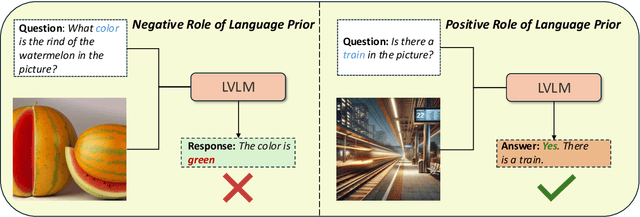
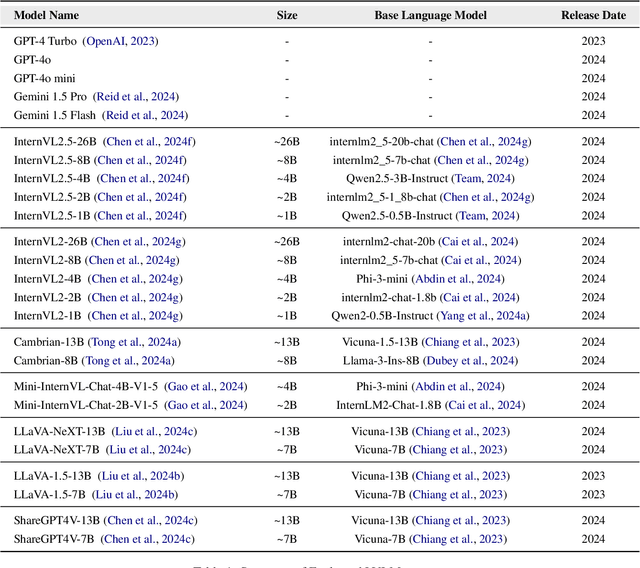
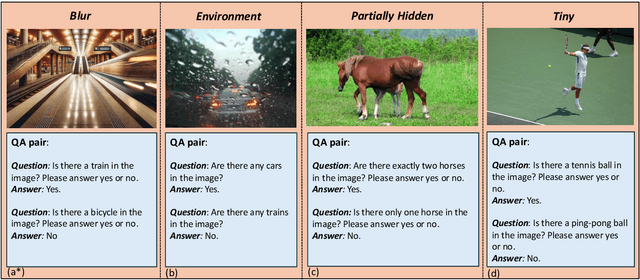
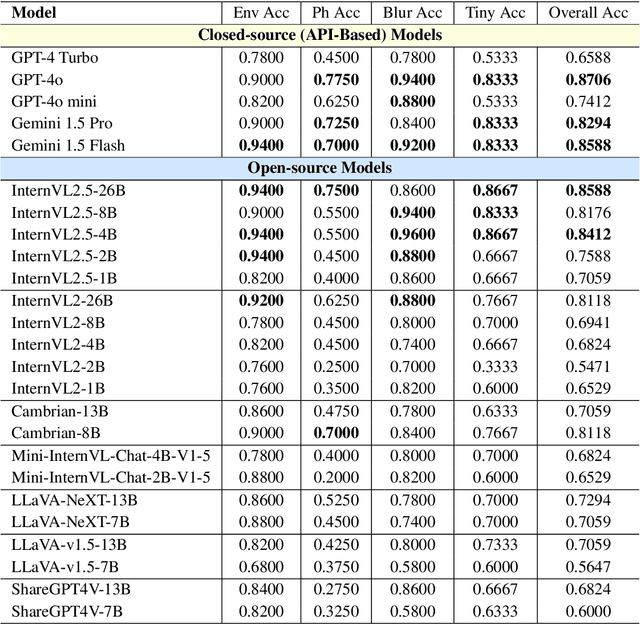
Abstract:Large Vision-Language Models (LVLMs) have shown impressive performance in various tasks. However, LVLMs suffer from hallucination, which hinders their adoption in the real world. Existing studies emphasized that the strong language priors of LVLMs can overpower visual information, causing hallucinations. However, the positive role of language priors is the key to a powerful LVLM. If the language priors are too weak, LVLMs will struggle to leverage rich parameter knowledge and instruction understanding abilities to complete tasks in challenging visual scenarios where visual information alone is insufficient. Therefore, we propose a benchmark called LanP to rethink the impact of Language Priors in LVLMs. It is designed to investigate how strong language priors are in current LVLMs. LanP consists of 170 images and 340 corresponding well-designed questions. Extensive experiments on 25 popular LVLMs reveal that many LVLMs' language priors are not strong enough to effectively aid question answering when objects are partially hidden. Many models, including GPT-4 Turbo, exhibit an accuracy below 0.5 in such a scenario.
LiSA: Leveraging Link Recommender to Attack Graph Neural Networks via Subgraph Injection
Feb 13, 2025Abstract:Graph Neural Networks (GNNs) have demonstrated remarkable proficiency in modeling data with graph structures, yet recent research reveals their susceptibility to adversarial attacks. Traditional attack methodologies, which rely on manipulating the original graph or adding links to artificially created nodes, often prove impractical in real-world settings. This paper introduces a novel adversarial scenario involving the injection of an isolated subgraph to deceive both the link recommender and the node classifier within a GNN system. Specifically, the link recommender is mislead to propose links between targeted victim nodes and the subgraph, encouraging users to unintentionally establish connections and that would degrade the node classification accuracy, thereby facilitating a successful attack. To address this, we present the LiSA framework, which employs a dual surrogate model and bi-level optimization to simultaneously meet two adversarial objectives. Extensive experiments on real-world datasets demonstrate the effectiveness of our method.
UniZyme: A Unified Protein Cleavage Site Predictor Enhanced with Enzyme Active-Site Knowledge
Feb 12, 2025Abstract:Enzyme-catalyzed protein cleavage is essential for many biological functions. Accurate prediction of cleavage sites can facilitate various applications such as drug development, enzyme design, and a deeper understanding of biological mechanisms. However, most existing models are restricted to an individual enzyme, which neglects shared knowledge of enzymes and fails generalize to novel enzymes. Thus, we introduce a unified protein cleavage site predictor named UniZyme, which can generalize across diverse enzymes. To enhance the enzyme encoding for the protein cleavage site prediction, UniZyme employs a novel biochemically-informed model architecture along with active-site knowledge of proteolytic enzymes. Extensive experiments demonstrate that UniZyme achieves high accuracy in predicting cleavage sites across a range of proteolytic enzymes, including unseen enzymes. The code is available in https://anonymous.4open.science/r/UniZyme-4A67.
Stealing Training Graphs from Graph Neural Networks
Nov 17, 2024


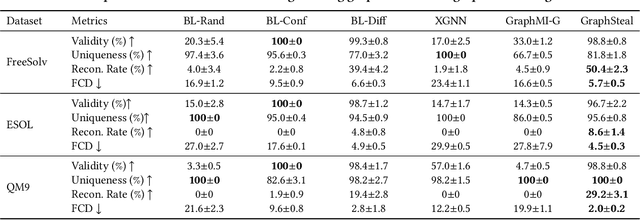
Abstract:Graph Neural Networks (GNNs) have shown promising results in modeling graphs in various tasks. The training of GNNs, especially on specialized tasks such as bioinformatics, demands extensive expert annotations, which are expensive and usually contain sensitive information of data providers. The trained GNN models are often shared for deployment in the real world. As neural networks can memorize the training samples, the model parameters of GNNs have a high risk of leaking private training data. Our theoretical analysis shows the strong connections between trained GNN parameters and the training graphs used, confirming the training graph leakage issue. However, explorations into training data leakage from trained GNNs are rather limited. Therefore, we investigate a novel problem of stealing graphs from trained GNNs. To obtain high-quality graphs that resemble the target training set, a graph diffusion model with diffusion noise optimization is deployed as a graph generator. Furthermore, we propose a selection method that effectively leverages GNN model parameters to identify training graphs from samples generated by the graph diffusion model. Extensive experiments on real-world datasets demonstrate the effectiveness of the proposed framework in stealing training graphs from the trained GNN.
Trojan Prompt Attacks on Graph Neural Networks
Oct 17, 2024



Abstract:Graph Prompt Learning (GPL) has been introduced as a promising approach that uses prompts to adapt pre-trained GNN models to specific downstream tasks without requiring fine-tuning of the entire model. Despite the advantages of GPL, little attention has been given to its vulnerability to backdoor attacks, where an adversary can manipulate the model's behavior by embedding hidden triggers. Existing graph backdoor attacks rely on modifying model parameters during training, but this approach is impractical in GPL as GNN encoder parameters are frozen after pre-training. Moreover, downstream users may fine-tune their own task models on clean datasets, further complicating the attack. In this paper, we propose TGPA, a backdoor attack framework designed specifically for GPL. TGPA injects backdoors into graph prompts without modifying pre-trained GNN encoders and ensures high attack success rates and clean accuracy. To address the challenge of model fine-tuning by users, we introduce a finetuning-resistant poisoning approach that maintains the effectiveness of the backdoor even after downstream model adjustments. Extensive experiments on multiple datasets under various settings demonstrate the effectiveness of TGPA in compromising GPL models with fixed GNN encoders.
Robustness-Inspired Defense Against Backdoor Attacks on Graph Neural Networks
Jun 14, 2024Abstract:Graph Neural Networks (GNNs) have achieved promising results in tasks such as node classification and graph classification. However, recent studies reveal that GNNs are vulnerable to backdoor attacks, posing a significant threat to their real-world adoption. Despite initial efforts to defend against specific graph backdoor attacks, there is no work on defending against various types of backdoor attacks where generated triggers have different properties. Hence, we first empirically verify that prediction variance under edge dropping is a crucial indicator for identifying poisoned nodes. With this observation, we propose using random edge dropping to detect backdoors and theoretically show that it can efficiently distinguish poisoned nodes from clean ones. Furthermore, we introduce a novel robust training strategy to efficiently counteract the impact of the triggers. Extensive experiments on real-world datasets show that our framework can effectively identify poisoned nodes, significantly degrade the attack success rate, and maintain clean accuracy when defending against various types of graph backdoor attacks with different properties.
Rethinking Graph Backdoor Attacks: A Distribution-Preserving Perspective
May 17, 2024

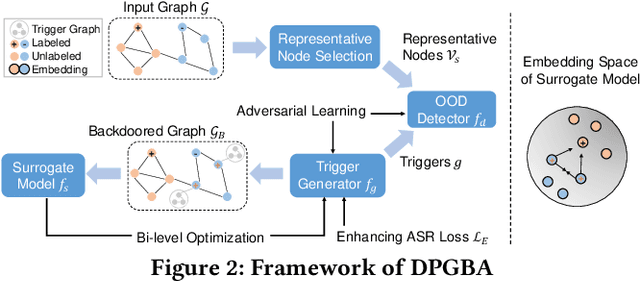

Abstract:Graph Neural Networks (GNNs) have shown remarkable performance in various tasks. However, recent works reveal that GNNs are vulnerable to backdoor attacks. Generally, backdoor attack poisons the graph by attaching backdoor triggers and the target class label to a set of nodes in the training graph. A GNN trained on the poisoned graph will then be misled to predict test nodes attached with trigger to the target class. Despite their effectiveness, our empirical analysis shows that triggers generated by existing methods tend to be out-of-distribution (OOD), which significantly differ from the clean data. Hence, these injected triggers can be easily detected and pruned with widely used outlier detection methods in real-world applications. Therefore, in this paper, we study a novel problem of unnoticeable graph backdoor attacks with in-distribution (ID) triggers. To generate ID triggers, we introduce an OOD detector in conjunction with an adversarial learning strategy to generate the attributes of the triggers within distribution. To ensure a high attack success rate with ID triggers, we introduce novel modules designed to enhance trigger memorization by the victim model trained on poisoned graph. Extensive experiments on real-world datasets demonstrate the effectiveness of the proposed method in generating in distribution triggers that can by-pass various defense strategies while maintaining a high attack success rate.
PreGIP: Watermarking the Pretraining of Graph Neural Networks for Deep Intellectual Property Protection
Feb 06, 2024
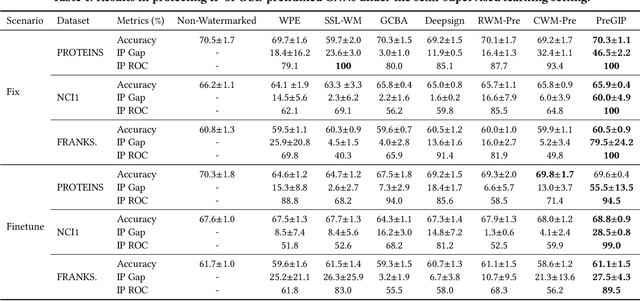

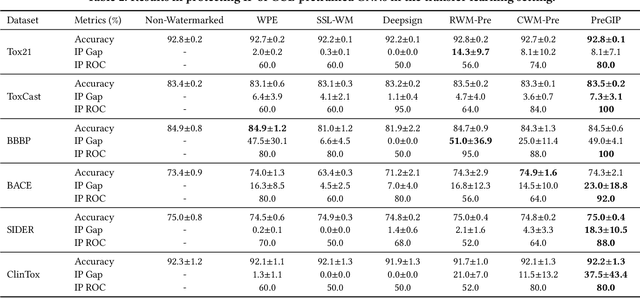
Abstract:Pretraining on Graph Neural Networks (GNNs) has shown great power in facilitating various downstream tasks. As pretraining generally requires huge amount of data and computational resources, the pretrained GNNs are high-value Intellectual Properties (IP) of the legitimate owner. However, adversaries may illegally copy and deploy the pretrained GNN models for their downstream tasks. Though initial efforts have been made to watermark GNN classifiers for IP protection, these methods require the target classification task for watermarking, and thus are not applicable to self-supervised pretraining of GNN models. Hence, in this work, we propose a novel framework named PreGIP to watermark the pretraining of GNN encoder for IP protection while maintain the high-quality of the embedding space. PreGIP incorporates a task-free watermarking loss to watermark the embedding space of pretrained GNN encoder. A finetuning-resistant watermark injection is further deployed. Theoretical analysis and extensive experiments show the effectiveness of {\method} in IP protection and maintaining high-performance for downstream tasks.
 Add to Chrome
Add to Chrome Add to Firefox
Add to Firefox Add to Edge
Add to Edge